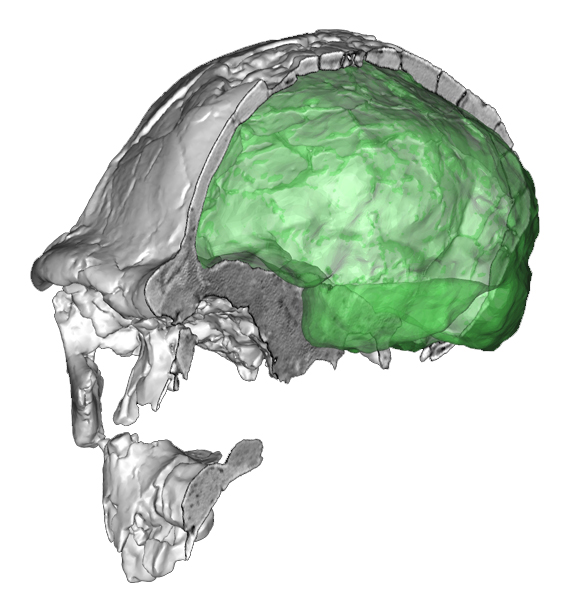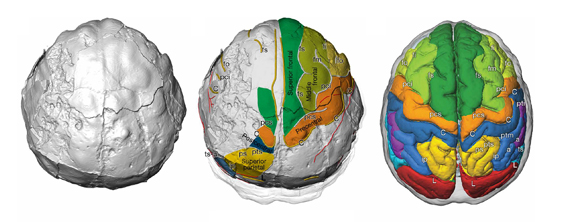A new outstanding article by Gunz and colleagues on australopiths and paleoneurology. With new digital reconstructions, and new brain volume and age at death estimates, they suggest that the brain of Australopithecus afarensis displayed an ape-like sulcal pattern, but a prolonged (human-like) growth. As usually, results should be interpreted with cautions, because of the uncertainties in the estimates, the difficulties to deal with sulcal imprint on endocasts, and the limited sample size. In paleontology, we have to take into account that very often we don’t have “samples”, but only “observations”, associated with few or even single specimens, extrapolations, and personal experience. Which is indeed a lot of valuable information, although it should not be associated with any sort of conclusive evidence. Another point that should be taken into consideration is the fact that, as usually in anthropology, one has the sensation that “chimp” is used as primitive reference, and “human” as a derived one. African apes are the result of independent lineages evolved for some million years to adapt to a rainforest habitat, so they are doubtful models for human evolution. Assuming they surely represent an ancestral state might be a risky bet. At the same time, Australopithecus was a genus probably counting with several species, and most of them (except one, that we can’t be sure to have found or identified) were not directly related to the human evolutionary radiation. So, as for chimps, also for australopiths we should not give for granted that they must necessarily lie somewhere along a (non-existent) chimp-human continuum. A final remark deals with the “prolongation” issue. Heterochrony can be associated with distinct kinds of processes which, in general, cannot be properly discriminated in fossils (actually, they are hard to investigate even in living species!). Different mechanisms can generate similar gross results, confounding possible interpretations on the process behind the observed phenotype. With all these issues in mind, we have nonetheless to say that the methodological approach employed in this study is probably the best one we can currently rely on in this field, and the results of this article are indeed striking. Personally, my only real concern deals with the fact that such a comprehensive and detailed analysis has been presented in a pay-for-publish journal, and not on standard (and better reputed) magazines.
Tag: Australopithecus
Little Foot
The endocast of the australopith StW 573 is pretty complete, and now Amélie Beaudet and colleagues have published a very detailed and comprehensive anatomical analysis of its features. For many paleoneurological traits we still miss a reliable knowledge on intra- and inter-specific variation but, according to what we can currently see in Australopithecus, Paranthropus and chimpanzees, StW 573 does not display derived sulcal patterns in the frontal and parietal regions. Its overall endocranial form resembles the morphology of some Paranthropus specimens, although in this case there are still some issues on deformation and possible taphonomic effects (specially at the frontal bone). The study supplies a careful description of the vascular patterns, in particular for the middle meningeal artery. In humans, only our species has generally a complex vascular network, while vessels are more scarce and less connected in extinct human taxa. Nonetheless, these same vessels (or, at least, their analogous networks) are more developed in apes. Therefore, australopiths are a key group to understand what happened with these traits, and to assess the polarity of these features in the evolution of distinct hominoid branches.
Australopithecus africanus
 Cranial capacity estimations and inferences in fossil species suffer two main limits: incompleteness of the endocranial anatomy and small sample size. Neubauer and colleagues have now published a very detailed paper on these factors, by using Australopithecus africanus as case-study. They provide new figures for the endocranial volume of this taxon, quantifying the effect of incompleteness and small samples on the estimations. This is not only useful to enhance our knowledge on australopiths’ cranial capacity, but it represents a real quantitative advance in paleoneurology as scientific discipline.
Cranial capacity estimations and inferences in fossil species suffer two main limits: incompleteness of the endocranial anatomy and small sample size. Neubauer and colleagues have now published a very detailed paper on these factors, by using Australopithecus africanus as case-study. They provide new figures for the endocranial volume of this taxon, quantifying the effect of incompleteness and small samples on the estimations. This is not only useful to enhance our knowledge on australopiths’ cranial capacity, but it represents a real quantitative advance in paleoneurology as scientific discipline.


